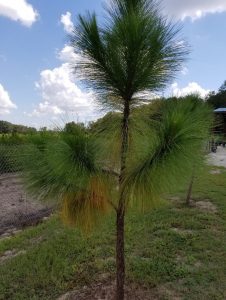Written by Greg Barton, Marion County Forester

Each year, as fall approaches – or what counts for fall in Florida – trees begin to respond to changes in the environment. The iconic image of autumn is a landscape of brilliant colored foliage as broad-leaved trees prepare to shed their leaves for the winter. In Florida we tend not to see this colorful show on a level associated with more northerly locations. Meanwhile, evergreen trees such as pines are expected to maintain their verdant green needles in perpetuity. But this is not the reality for Fall coniferous pines.
Pine trees and other “evergreen” cone-bearing species experience a seasonal needle drop that is a normal part of the plant’s life cycle. Needles of conifers have varying life spans and do not remain attached indefinitely to the tree. In Florida, needles commonly persist for about one and a half or two and a half years. As they reach “old age”, needles will begin to turn bright yellow, then eventually brown, and are released. The change can be gradual, or, with some species, quite rapid. This seasonal needle drop can cause concern to homeowners who are not familiar with this natural occurrence. In times of drought, needle discoloration may be particularly noticeable, because more needles are shed in response to environmental stress.
Fall needle drop is an annual event that will occur all across the landscape, although not necessarily all at once. Even pines growing side by side may exhibit different levels and timing of needle loss. Other environmental conditions such as rainfall and temperature changes will impact the timing and intensity of the coloration. In some years, a similar loss of older needles may occur at different times, such as spring or summer, in response to drought stresses, or even flooding.
There are many cultural, insect, disease, and environmental issues that result in pines needles discoloring and falling off. The key to differentiating them from this seasonal change is that other issues usually affect most or all of the needles, or do not go through the bright yellow phase. There is an exception here for older branches lower on the trunk or heavily shaded, where the tree is preparing to shed or “self-prune” the entire branch.

It is interesting to note that the needles are not simply dying and falling off. Pine trees will effectively recycle nutrients such as nitrogen and phosphorus from the needles, drawing them back into tree, similar to the process broad-leaved trees go through in the fall. This is a living function for the tree as it prepares to cast off the oldest needles that have served for almost three seasons. Nutrients such as calcium and magnesium do not translocate and remain in the needles when they fall. As the green chlorophyll breaks down and various chemicals are drawn from the leaves, the yellow and orange colors are revealed.
It should be reassuring to the homeowner with only a few pines, or the landowner with many acres, that this natural process is an indication of a healthy tree that is going through a normal annual progression. This bright yellow color is still attractive, but is normally overwhelmed by the remaining green needles of the tree.
Remember too that because these needles are not affected by diseases, as they fall they can be collected to be used as a healthy, natural, and attractive mulch. They will also recycle back into the soil if allowed to remain or are mowed over without collecting the clippings.
No cause for alarm! Although these pines may never approach the majesty of a Sugar Maple in full scarlet standing beside a watermill, they are still following an ancient cycle tied to the changing seasons. In spring, a new crop of needles will emerge, to begin their service to their parent tree.
Greg Barton, is a Senior Forester and ISA Certified Arborist with the Florida Forest Service serving in Marion County at the Indian Lake Forestry Station in Ocala.
 0
0
